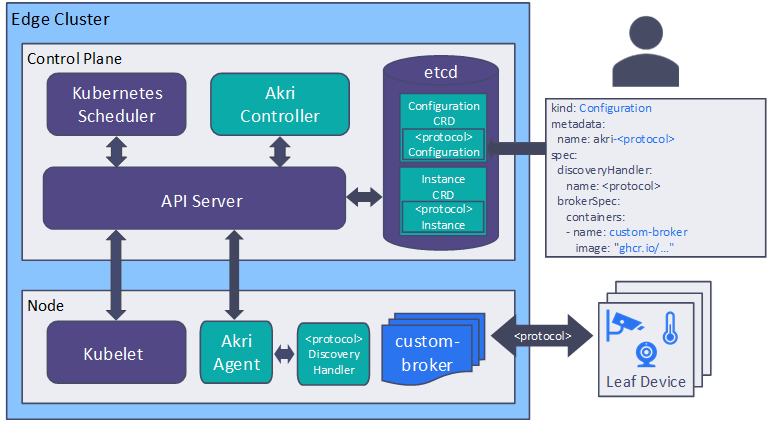Akri services architecture
Important
Azure IoT Operations Preview – enabled by Azure Arc is currently in PREVIEW. You shouldn't use this preview software in production environments.
You will need to deploy a new Azure IoT Operations installation when a generally available release is made available, you won't be able to upgrade a preview installation.
See the Supplemental Terms of Use for Microsoft Azure Previews for legal terms that apply to Azure features that are in beta, preview, or otherwise not yet released into general availability.
This article helps you understand the architecture of the Akri services. After you learn about the core components of the Akri services, you can use them to detect devices and assets, and add them to your Kubernetes cluster.
The Akri services are a Microsoft-managed commercial version of Akri, an open-source Cloud Native Computing Foundation (CNCF) project.
Core components
The Akri services consist of the following five components:
- Akri configuration is a custom resource where you name a device. This configuration tells the Akri services what kind of devices to look for.
- Akri instance is a custom resource that tracks the availability and usage of a device. Each Akri instance represents a leaf device.
- Akri discovery handlers look for the configured device and inform the agent about discovered devices.
- Akri agent creates the Akri instance custom resource.
- Akri controller helps you to use a configured device. The controller sees each Akri instance and deploys a broker pod that knows how to connect to and use the resource.

Custom resource definitions
A custom resource definition (CRD) is a Kubernetes API extension that lets you define new object types. There are two Akri services CRDs:
- Configuration
- Instance
Akri configuration CRD
The configuration CRD configures the Akri services. You create configurations that describe the resources to discover and the pod to deploy on a node that discovers a resource. To learn more, see Akri configuration CRD. The CRD schema specifies the settings all configurations must have, including the following settings:
- The discovery protocol for finding resources. For example, ONVIF or udev.
spec.capacitythat defines the maximum number of nodes that can schedule workloads on this resource.spec.brokerPodSpecthat defines the broker pod to schedule for each of these reported resources.spec.instanceServiceSpecthat defines the service that provides a single stable endpoint to access each individual resource's set of broker pods.spec.configurationServiceSpecthat defines the service that provides a single stable endpoint to access the set of all brokers for all resources associated with the configuration.
Akri instance CRD
Each Akri instance represents an individual resource that's visible to the cluster. For example, if there are five IP cameras visible to the cluster, there are five instances. The instance CRD enables Akri services coordination and resource sharing. These instances store internal state and aren't intended for you to edit. To learn more, see Resource sharing in-depth.
Agent
The Akri agent implements Kubernetes Device-Plugins for discovered resources. The Akri Agent performs the following tasks:
- It watches for configuration changes to determine the resources to search for.
- It monitors resource availability to determine what resources to advertise. In an edge environment, resource availability changes often.
- It informs Kubernetes of any changes to resource health and availability.
These tasks, combined with the state stored in the instance, enable multiple nodes to share a resource while respecting the limits defined by the spec.capacity setting.
To learn more, see Agent in-depth.
Discovery handlers
A discovery handler finds devices. Examples of device include:
- USB sensors connected to nodes.
- GPUs embedded in nodes.
- IP cameras on the network.
The discovery handler reports all discovered devices to the agent. There are often protocol implementations for discovering a set of devices, whether a network protocol like OPC UA or a proprietary protocol. Discovery handlers implement the DiscoveryHandler service defined in discovery.proto. A discovery handler is required to register with the agent, which hosts the Registration service defined in discovery.proto.
To learn more, see Custom Discovery Handlers.
Controller
The goals of the Akri controller are to:
- Create or delete the pods and services that enable resource availability.
- Ensure that instances are aligned to the cluster state at any given moment.
To achieve these goals, the controller:
- Watches out for instance changes to determine what pods and services should exist.
- Watches for nodes that are contained in instances that no longer exist.
These tasks enable the Akri controller to ensure that protocol brokers and Kubernetes services are running on all nodes and exposing the desired resources, while respecting the limits defined by the spec.capacity setting.
For more information, see the documentation for Controller In-depth.